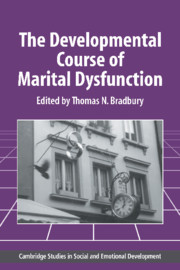Introduction: The Developmental Course of Marital Dysfunction
Published online by Cambridge University Press: 13 October 2009
Summary
About 90% of all Americans will marry at some point in their life.
U.S. Bureau of the Census, 19921.2 million divorces, or about 23,000 per week, were granted in 1994.
De Vita, 1996The likelihood that a first marriage will end in separation or divorce is now greater than the likelihood that it will continue.
Bumpass, 1990More than 1 million children under age 18 saw their parents divorce in 1990.
Ahlburg & De Vita, 1992Relationship problems are the primary reason why people seek counseling in the United States.
Veroff, Kulka, & Douvan, 1981Sociodemographic facts such as the ones just cited have become well known to the public and are cited frequently by social scientists as justification for studying marriage. Since the 1970s scholars from a number of disciplines, building on the pioneering work of sociologists, have focused their attention on the diverse and complex phenomena associated with marriage – most commonly on the question of what makes marriages satisfying and stable – and their efforts have precipitated many important conceptual, methodological, and empirical advances. This work has gone through three fundamental transitions, and each has served to shape how marriage is conceived and examined.
The First and Second Transitions: Studying Interpersonal and Intrapersońal Facets of Marriage
In the first transition, which began more than two decades ago, many family scientists rejected the prevailing views that (a) marriage could be understood by studying individual spouses rather than their relationship; and (b) spouses' self-reports, when collected in the absence of other forms of data, were particularly informative.
- Type
- Chapter
- Information
- The Developmental Course of Marital Dysfunction , pp. 1 - 8Publisher: Cambridge University PressPrint publication year: 1998
- 6
- Cited by



